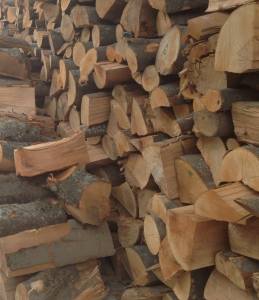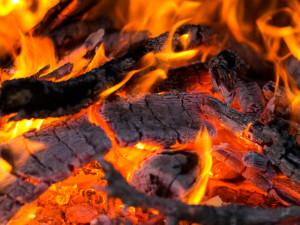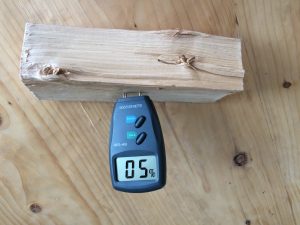Looking after your stove and flue is essential. Don’t treat it like a furnace and use the right fuel. This will prolong the life of your stove and flue system and often prevents chimney fires. It will also stop your flue and stove from falling apart!
Environmentally, you also have a responsibility in using the right fuel. Initiatives such as “Ready To Burn” from Woodsure will provide more information on this and where to find quality fuel suppliers.
Starting a fire
Firelighters
We prefer using firelighters over paper since they produce no ash and therefore you won’t have to clean out your stove as much! We prefer the eco firelighters as your hands don’t smell after handling them!
Kindling
This is probably one of the most important aspects you’ll need to light your fire and you should look to see if you can buy this in bulk. You will always need a ready supply of it, and we tend to have a basket dedicated to kindling.
Wood fuel: eco-logs & wood
If your stove is a wood burner, you can only use eco-logs or wood as your fuel. If your stove is a multi-fuel stove and the flue can accommodate it (twin wall flue, 904L, or W3G), you can burn wood and smokeless fuel. However, you should avoid burning both fuels together since the water content from the wood will mix with the copious amounts of ash from the smokeless fuel and you’ll create a toxic tar called creosote, that damages flues and stoves.
We are against the use of smokeless fuel as it can easily be overloaded, burn too hot and damage liners and stoves.
Eco-logs
These briquettes are formed as cylinders or cubes from compressed woody biomass. They are gaining popularity for all the right reasons since they are a very eco-friendly way to fuel your stove. They are easily available in most DIY stores, homeware stores, garages, and supermarkets. You can also buy them in bulk easily on-line too. When you store them, they should be stored completely dry such as in your garage or shed, as any water will destroy them!
You should expect to pay between £5-£6 for a bag. The way you use these logs is very different to normal logs. It is best to break the logs into 2-4 pieces depending on the size of the log (smash them against each other). Some of them will expand, so you should be careful about this too and air on the size of caution to start off with.
If used correctly, they are a very economical way to fuel your fire, and we’ve personally found them to be better value than wood.
The only downside to eco-logs is that they seem to produce a lot of ash, meaning that you’ll need to clear out the stove more often that if you were just using seasoned/kiln dried logs. That said, eco-logs are our preferred form of fuel which we often use in combination with seasoned logs – either Ash or Birch.
Wood
If you choose the right type, it burns well, gives off plenty of heat, smells nice, produces little ash, is carbon neutral, and does not affect air pollution.
If you choose wrong, the heat output will be reduced; it will damage your stove and flue, cause health issues, stink, clog up your flue and cloud your stove glass.
Each species of wood produces varying heat. This is known as the calorific value. Ash has a high calorific value so is a good wood to burn.
Hardwood V’s softwood
Hardwood is denser than softwood, therefore burns for longer. Typically, you will burn three hardwood logs and get the same amount of burn time and heat from burning four softwood logs that are the same size and species. Consequently, hardwood is more expensive.
Seasoned logs

Seasoned logs have been left to “season” outside. A proper seasoned log will have been split and stacked correctly in a well-ventilated, dry place. A cover such as a slanted roof or a tarpaulin will be used to keep the rainwater off. The lower layer of logs will be raised from the floor so that air can move, and moisture can escape.
The actual type of log and its geographical location will determine how long it needs to be “seasoned” until the moisture content is below 20%. Two years is a good amount of time to season wood if stacked correctly. The previous
school of thought of 6-18 months isn’t realistic to achieve a moisture content under 20%.
Incidentally, if you buy seasoned logs, you should stack and store them correctly to continue seasoning them.
Kiln dried logs
Kiln dried logs have actually been kiln dried. This process dries out the log so that when it is put on a fire, it releases heat immediately. For each type of species, the simple science behind it is that the dryer the log, the higher the calorific value. This simply means that you get more heat from it. Therefore, a kiln dried log gives you more heat than a seasoned one. Consequently, unit for unit, kiln dried logs are more expensive.
However, this shouldn’t put you off. If you use the logs wisely and don’t have the stove on full throttle all the time, it will be financially better for you to buy kiln dried logs over any other type of wood. You will get more heat burning the kiln-dried logs than you would by burning other wood. It basically means that you will be using less fuel to heat your room. And your stove and flue will love you for it as there will be less ash created. The downside to kiln dried logs is environmentally since the kiln will need to be fired up in the first instance to help dry the logs and the question remains as to how efficient this process really is.
Checking the moisture content
The moisture content of a log will determine how “dry” it is. A newly felled tree can have more than 50% moisture content.
All manufacturers of flues and stoves recommend the minimum moisture content of wood to be used on stoves and flues should be 20% and under. A well-seasoned log should be 20% and under. A kiln dried log about 15-18%. A moisture meter can be used to help determine the moisture content. Just touch it in the split end of the wood for an immediate digital reading. Moisture meters can cost as little as £15.00.
Green logs
If you burn wet or “green” logs, you may as well be throwing a cup of water on your fire every time you put a log on. It will soon destroy your stove and flue and it will also cause air pollution. “Particulate matter” is released, which in turn have been proven to cause serious health issues such as lung diseases. Furthermore, the amount of heat released from a green log is miniscule as the fire spends most of the time drying out the log (that’s the spitting and hissing sound you hear). By the time the log is ready to properly burn and give off heat, there is hardly anything left of it! It is extremely inefficient. Burning green logs is just bad news.
How much wood will I need?
I can only guide you on this, as there are many variables involved. For example, the number of logs you will use may depend on the actual size of the log, how efficient your stove is and how you use the appliance. There is also the factor of softwood V’s hardwood and kiln dried Vs seasoned. You might be experiencing a very cold spell, so you’ll want to get the stove up to speed fast and kicking out a good bit of heat before allowing it to settle into its normal heating flow.
However, to give you an idea, for a 5kw stove, you should expect to use a hardwood log every 45-60 minutes of constant use. If your stove is higher than a 5Kw stove, then this amount will likely increase and even double as you will be needing more logs to refuel to maintain the higher heating output.
Softwood logs burn faster, so you’ll go through more of these. So, if your stove is rated at about 5Kw, you might burn between 5-7 logs per night. If you use the stove for 5 nights a week and use it from September through to March, this can equate to a lot of logs!
Most customers tend to get about 3 cubic meters of logs per season. Prices are changing all the time, but I expect this will cost about £450 per season.
Where to buy wood
I suggest that you shop around and see what offers are available. Many of my customers regularly rate the following suppliers as they fell and manage local Cornish forestry. Locally produced kiln dried hardwood ash, oak and birch – Geddon! The wood will typically be delivered in nets or biodegradable bags easy for storage;
• Cornish Firewood – 01209 899301
• Mark Willis Firewood – 07967 723421
• Ashwins – 01503 273023
• Taylor Newman – 07903 460805
Where to buy eco-logs
Most DIY stores and supermarkets sell them. Unfortunately, they are quite expensive when buying small amounts. We have found that the best place to buy them in bulk is through sites that sell them by full or half pallet loads. We’ve used White Horse Energy (www.whitehorseenergy.co.uk/briquettes) and prefer the Ecoblaze Aspen briquettes (https://www.whitehorseenergy.co.uk/briquettes/ecoblaze-aspen-wood-briquettes)
If you do go down the bulk buying route, it will work out cheaper for you, but you really need somewhere to store them that is dry – such as a garage or a dry outdoor storage unit such as a 1200L wheelie/bike storage unit that can be bought from places such as Wickes, B & Q, Argos, and the likes.
You definitely want to make sure that this storage area is dry as any moisture/water will destroy them, and they’ll return to lump of sawdust!
Smokeless fuel
Wood burners are set up to burn wood products only. Multi fuel stoves are set up to burn both wood and smokeless fuel. Smokeless fuel is not coal. Coal should NOT be used on your stove: Coal contains a large amount of petroleum coke that combusts at a very high temperature and damages stoves and flue components. It will likely warp your stove and burn through your flue!
We personally think that similar issues occur with smokeless fuel and mostly because of user error as people tend to either:
1 – Put too much fuel on their stoves
2 – Burn it with wood
3 – Allow it to smoulder
4 – Combinations of all the above
The problems that we have personally found with any of the above is that stoves and flues become damaged and need replacing. Green or wet (non-seasoned) wood or wood that is glued together or treated is also bad news for stoves as this is known to clog up flues, and lead to poorer air quality.
If you are dead set on using smokeless fuel, our advice is to use it sparingly (don’t over-fuel/overload) and don’t mix it with wood; This will produce too much soot and water that will convert into a tar called creosote. Creosote is bad news for flues – it is sticky and highly flammable and that is a main cause for chimney fires.
HETAS have tested and approved various types of smokeless fuels. However, if you really want to go ahead and use smokeless fuel, there is only one type of smokeless fuel that we recommend you use on your stove, as unlike most other smokeless fuels, this type does not have any petroleum coke present or other harmful additives. It just contains anthracite and molasses (natural sugars that help ignite it).
This smokeless fuel is called Maxibrite and is mined on a Welsh colliery. It is slightly more expensive than other brands of smokeless fuel, but it is quality.
Local Maxibrite suppliers:
• K. Abrahams from Redruth – 01209 213803
• Semmens from Penzance – 01736 787643
Other forms of fuel
Pallets
These can be a great source of kindling. However, like all types of wood fuel, you should avoid any wood that is pressure treated or has any glue. This includes plywood. These glues and chemicals will be released on combustion and will not only clog up your stove and flue but will increase air pollution.
Timber offcuts
As above, only use if they are not treated. Using too many small pieces too often, will create too much heat and may damage/warp the stove and liner.
Driftwood
Driftwood tends to have a high salt content. The salt will damage your appliance and cause it to rust. The moisture content will also be fairly high too.
Foraging
Unfortunately, this activity is largely illegal. You’ll likely need permission from the landowner. Most public land is run by the forestry commission and in 2008, the law was changed (due to health and safety!) to prevent the common man taking deadwood. Previously this law was made in the Magna Carta!


